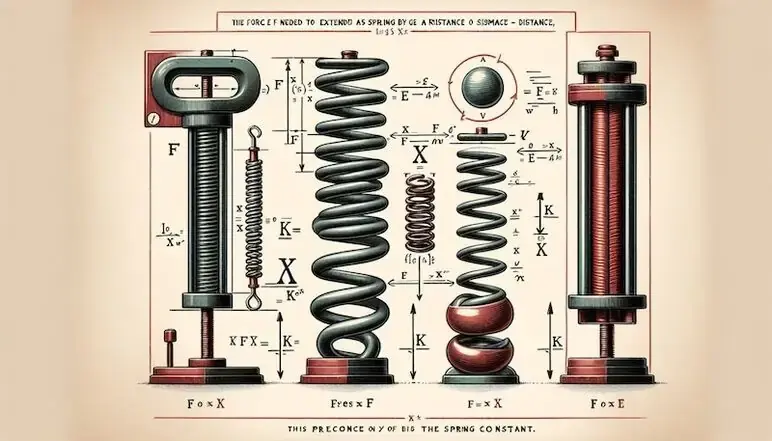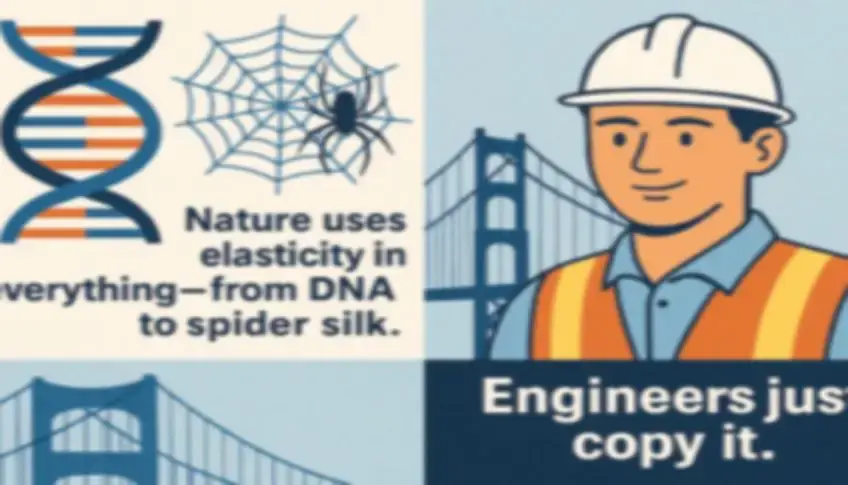Practical Applications of Elastic Behaviour in Engineering and Daily Life
Making use of If you watch how things bounce when you pull on them, you can learn about how elastic materials are. It shows how their shape changes when you pull or push on them. They go back to how they were when you stopped. If you push and stretch the same amount, Hooke’s Law says that they are the same. This is why they act this way.
Bending things is one way to make them. It’s important for bridges and rubber bands. Making things safer and stronger is possible for people who know how to move them. These ideas make sure that everything works right, from little things to huge buildings.
This writing is also about how things can bend and then go back to their original shape. It’s called Applications of Elastic Behaviour of Materials. We’ll look at this skill in a lot of different ways. We’ll talk about how it works in the real world and show you how it works in the lab.
The Science Behind Elastic behaviour in materials
Additionally, elasticity is the property of a material to regain its original shape and size after the removal of deforming forces. Hooke’s Law governs this fundamental concept.
Within the elastic limit, stress is directly proportional to strain.
F = -kx
Where:
- F = Restoring force
- k = Spring constant (stiffness)
- x = Displacement
Additionally, elasticity is not just a theoretical concept—it has real-world engineering and technological applications that impact everything from skyscrapers to medical implants.

Applications of elastic behaviour of materials in real-life applications
1. Structural Engineering: Buildings and Bridges
Things that are elastic stay strong even when they are pushed by wind, weather, or cars. This is not how they break. People use these since they are stiff. And can be made back into the way they were before.
When there is weight on a suspended bridge, the ropes stretch. Their form changes, but they go back to how they were before. Buildings that can stand up to earthquakes: Some parts of buildings can take the shock of an earthquake.
A well-designed structure bends but doesn’t break—just like a tree in a storm. — Civil Engineering Principle
2. Mechanical Engineering: Springs and Shock Absorbers
Machines and cars need to be able to stretch:
Additionally, to handle the bumps in the road, coil springs in car suspensions bend and stretch. Engines and other heavy gear have springs that keep them from shaking too much. Elastic fasteners on train tracks let the track slowly get wider and narrower as the weather changes.
Why are steel springs used?
Steel and springs work well together. It might get long. Then return to its original shape. If that much metal was stretched. They were going to break or stay bent. Up to about 0.2 percent, steel can stretch without change. It starts to bend if you stretch it past that point.
3. Aerospace and Automotive Design
Aircraft and cars rely on elastic materials for safety and fuel efficiency:
- Wings on airplanes are made to bend easily in rough air so they don’t crack.
- Tires: The stretchiness of rubber makes sure that they grip and absorb shock.
- For crash safety, crumple zones in cars use controlled plastic deformation when the limit of elasticity is reached.
Know What?
Carbon fiber is used in the Boeing 787 Dreamliner. So this stuff is lighter and stronger than the metal used in older planes. Some old planes were made of materials that were good for a long time, but carbon fiber is better in some ways.
Fun Fact: Airplane wings bend in the wind so they don’t snap!

4. Medical Applications: Implants and Devices
Modern medicine uses elastic biomaterials widely:
- Modern medicine frequently uses elastic biomaterials for two key applications:
- Medical device manufacturers craft most stents from Nitinol—a nickel-titanium alloy that expands within arteries while retaining its predefined shape.
- Biomaterial engineers design artificial cartilage from specialized elastic polymers that mimic natural tissue, enabling seamless biological integration.
- When you wear orthodontic braces, a constant stretchy force moves your teeth into place over time.
So why does elasticity matter in medicine? Essentially, implants must flex naturally with body movements without fracturing, ensuring both comfort and longevity.
Nature uses elasticity in everything—from DNA to spider silk. Engineers just copy it — Materials Scientist
5. Consumer Products and Sports Equipment
In everyday life, elastic materials enhance performance and comfort:
- Running shoes: The foam in the heel actively contracts and expands to cushion each step.
- Tennis rackets have carbon-fiber frames that store and release elastic energy more efficiently, which makes hits stronger.
- Memory foam mattresses: These give you personalized pain relief by molding to your body shape thanks to their viscoelasticity.
How Elastic Materials Work:
When you stretch something elastic, it stores energy—like a spring. The more you pull, the more energy it holds (up to a point). Then, when you let go, it snaps back to shape, releasing that energy.
This “stretch and return” ability is why we use elastic materials in:
- Springs (they bounce back)
- Rubber bands (they stretch and snap)
- Shoe soles (they absorb shock)
The key? The material must return to its original shape after bending. If stretched too far, it breaks or stays bent. That’s why engineers test materials carefully!
Think of it like a slingshot:
- Pull (stores energy)
- Hold (keeps energy)
- Release (energy pushes the object)
This simple science makes cars safer, buildings stronger, and even helps doctors fix hearts!
FAQ’s
1. What is the difference between elastic and plastic deformation?
- Elastic: Temporary, reversible deformation (e.g., stretching a rubber band).
- Plastic: Permanent deformation (e.g., bending a paperclip beyond its limit).
2. Why do bridges have expansion joints?
To allow thermal expansion/contraction without causing stress fractures.
3. How is Young’s modulus used in material selection?
It measures stiffness:
- High Young’s modulus (E): Rigid materials (e.g., diamond, steel).
- Low E: Flexible materials (e.g., rubber, foam).
4. Can a material be perfectly elastic?
No real material is perfectly elastic—all have some energy loss (hysteresis).
5. What happens if stress exceeds the elastic limit?
The material undergoes plastic deformation and may fracture.
Conclusion
This is a very important thing to remember when building things. We don’t always notice it. Knowing how things change. How do springs work? And what materials help us make buildings that are stronger and last longer? It also leads to a lot of new ideas. Engineers and scientists use this data to figure out how much weight something can hold. And to make implants that are easy to bend. For the most part, these ideas help us improve technology. Which changes the world we live in now?
Elastic materials are things that bend but don’t break. When you pull them, they stretch. When you let go, they go back to their shape. This is very useful in real life!
Even doctors use elastic materials! Stents in your body stretch to keep blood flowing. Braces slowly move teeth because they have stretchy wires.
Scientists study this to make better buildings, machines, and medical tools. Elasticity helps make things safer, stronger, and last longer.
References
- Andita, N., Rahmadani, M. R., Pratama, T. A. N., Mubarak, H., Fitriana, F., & Lestari, N. A. (2024). Elasticity in daily life: A potential topic in learning physics. International Journal of Research and Community Empowerment, 2(2), 65–73. https://doi.org/10.58706/ijorce.v2n2.p65-73
- Hadianfard, M. A., Marzouk, H., & Shafieyanb, C. (2017). Strength and elastic moduli of a concrete bridge using advanced nondestructive techniques. Scientia Iranica, 24(3), 942–952. https://doi.org/10.24200/sci.2017.4078
Additionally, to stay updated with the latest developments in STEM research, visit ENTECH Online. Basically, this is our digital magazine for science, technology, engineering, and mathematics. Furthermore, at ENTECH Online, you’ll find a wealth of information.






